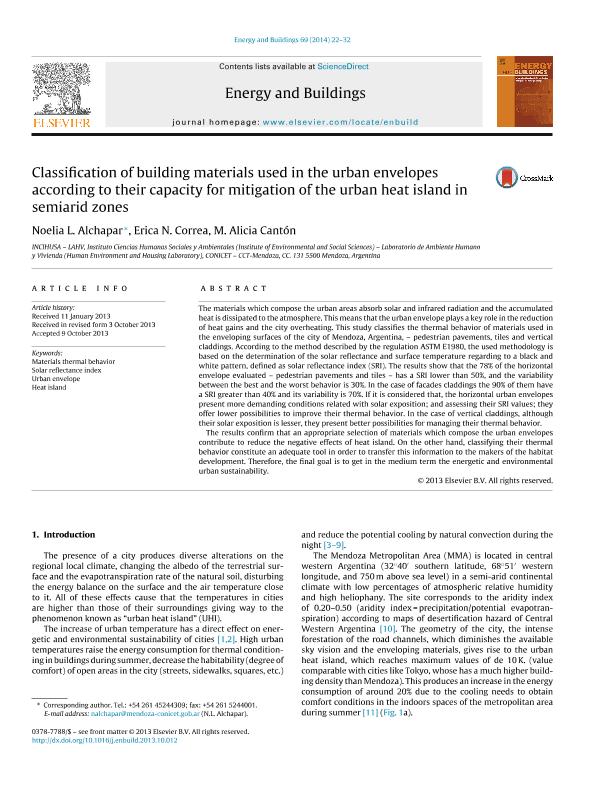Mostrar el registro sencillo del ítem
dc.contributor.author
Alchapar, Noelia Liliana

dc.contributor.author
Correa Cantaloube, Erica Norma

dc.contributor.author
Canton, Maria Alicia

dc.date.available
2017-07-05T20:47:16Z
dc.date.issued
2014-02
dc.identifier.citation
Alchapar, Noelia Liliana; Correa Cantaloube, Erica Norma; Canton, Maria Alicia; Classification of building materials used in the urban envelopes according their capacity for mitigation the urban heat island in semiarid zones; Elsevier Science Sa; Energy And Buildings; 69; 2-2014; 22-32
dc.identifier.issn
0378-7788
dc.identifier.uri
http://hdl.handle.net/11336/19700
dc.description.abstract
The materials which compose the urban areas absorb solar and infrared radiation and the accumulated heat is dissipated to the atmosphere. This means that the urban envelope plays a key role in the reduction of heat gains and the city overheating. This study classifies the thermal behavior of materials used in the enveloping surfaces of the city of Mendoza, Argentina, – pedestrian pavements, tiles and vertical claddings. According to the method described by the regulation ASTM E1980, the used methodology is based on the determination of the solar reflectance and surface temperature regarding to a black and white pattern, defined as solar reflectance index (SRI). The results show that the 78% of the horizontal envelope evaluated – pedestrian pavements and tiles – has a SRI lower than 50%, and the variability between the best and the worst behavior is 30%. In the case of facades claddings the 90% of them have a SRI greater than 40% and its variability is 70%. If it is considered that, the horizontal urban envelopes present more demanding conditions related with solar exposition; and assessing their SRI values; they offer lower possibilities to improve their thermal behavior. In the case of vertical claddings, although their solar exposition is lesser, they present better possibilities for managing their thermal behavior.
The results confirm that an appropriate selection of materials which compose the urban envelopes contribute to reduce the negative effects of heat island. On the other hand, classifying their thermal behavior constitute an adequate tool in order to transfer this information to the makers of the habitat development. Therefore, the final goal is to get in the medium term the energetic and environmental urban sustainability.
dc.format
application/pdf
dc.language.iso
eng
dc.publisher
Elsevier Science Sa

dc.rights
info:eu-repo/semantics/openAccess
dc.rights.uri
https://creativecommons.org/licenses/by-nc-sa/2.5/ar/
dc.subject
Materials Theermal Behavior
dc.subject
Solar Reflectance Index
dc.subject
Urban Envelope
dc.subject
Heat Island
dc.subject.classification
Otras Ingeniería del Medio Ambiente

dc.subject.classification
Ingeniería del Medio Ambiente

dc.subject.classification
INGENIERÍAS Y TECNOLOGÍAS

dc.title
Classification of building materials used in the urban envelopes according their capacity for mitigation the urban heat island in semiarid zones
dc.type
info:eu-repo/semantics/article
dc.type
info:ar-repo/semantics/artículo
dc.type
info:eu-repo/semantics/publishedVersion
dc.date.updated
2017-06-08T20:13:44Z
dc.journal.volume
69
dc.journal.pagination
22-32
dc.journal.pais
Países Bajos

dc.journal.ciudad
Amsterdam
dc.description.fil
Fil: Alchapar, Noelia Liliana. Consejo Nacional de Investigaciones Científicas y Técnicas. Centro Científico Tecnológico Conicet - Mendoza. Instituto de Ciencias Humanas, Sociales y Ambientales; Argentina
dc.description.fil
Fil: Correa Cantaloube, Erica Norma. Consejo Nacional de Investigaciones Científicas y Técnicas. Centro Científico Tecnológico Conicet - Mendoza. Instituto de Ciencias Humanas, Sociales y Ambientales; Argentina
dc.description.fil
Fil: Canton, Maria Alicia. Consejo Nacional de Investigaciones Científicas y Técnicas. Centro Científico Tecnológico Conicet - Mendoza. Instituto de Ciencias Humanas, Sociales y Ambientales; Argentina
dc.journal.title
Energy And Buildings

dc.relation.alternativeid
info:eu-repo/semantics/altIdentifier/url/http://www.sciencedirect.com/science/article/pii/S0378778813006580
dc.relation.alternativeid
info:eu-repo/semantics/altIdentifier/doi/http://dx.doi.org/10.1016/j.enbuild.2013.10.012
Archivos asociados
